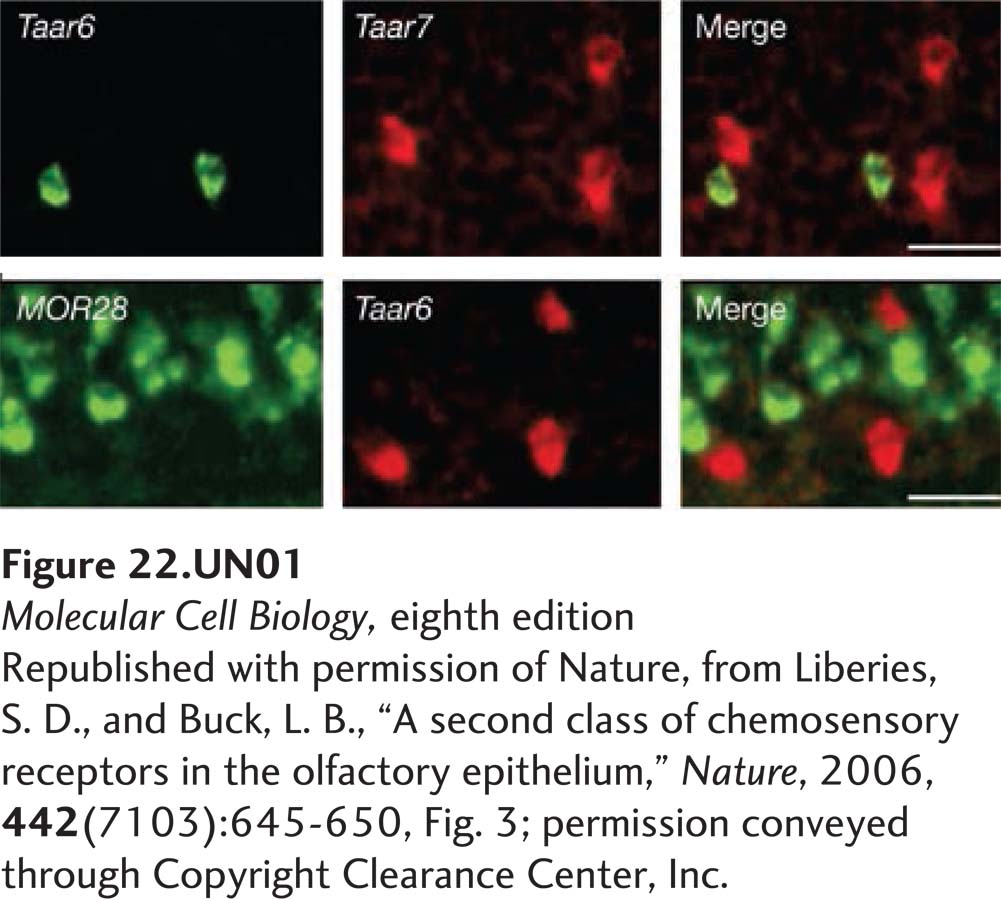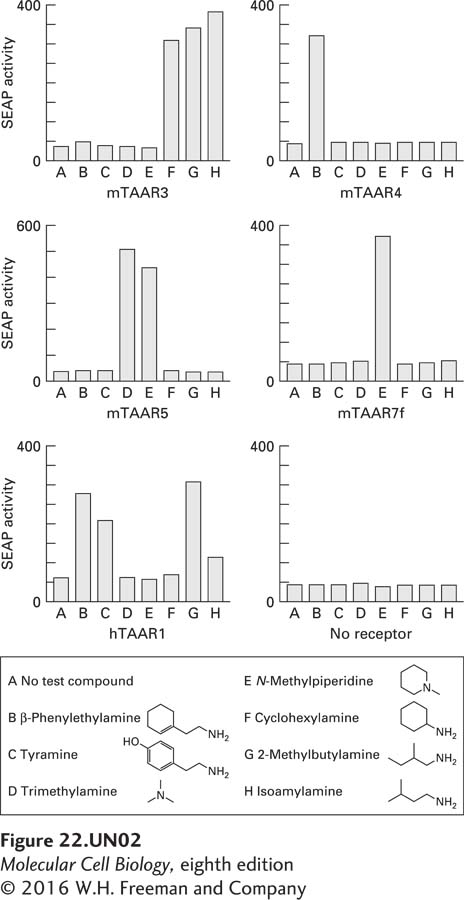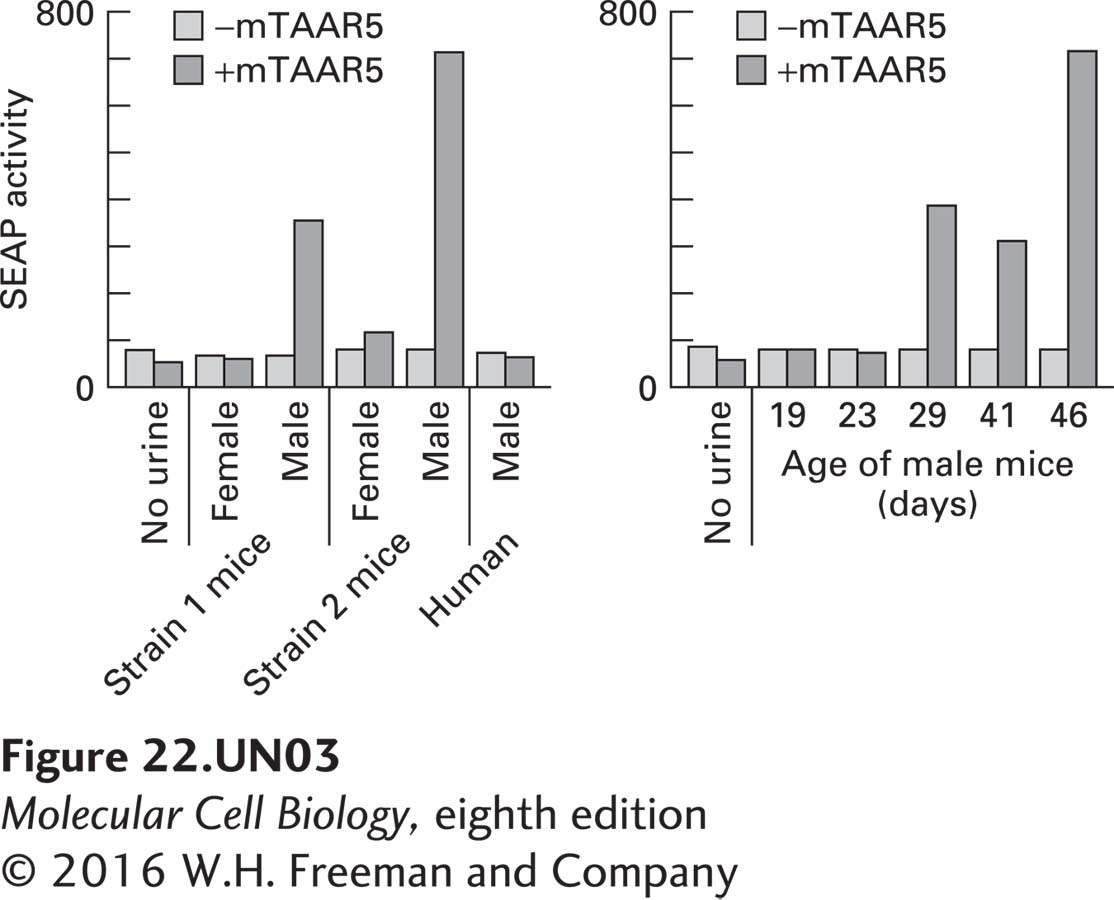Chapter 22. Expression Patterns of Olfactory Receptors
Introduction

Analyze the Data 22-1: Expression Patterns of Olfactory Receptors
Olfaction occurs when volatile compounds bind to specific odorant receptors. In mammals, each olfactory receptor neuron in the olfactory nasal epithelium expresses a single type of odorant receptor. These odorant receptors constitute a large multigene family (>1000 members) of related proteins. Binding of odorant induces a signaling cascade that is mediated via a G protein, Gαolf. Recent studies suggest that there are a small number of olfactory sensory neurons in the nasal epithelium that express members of the trace-amine–associated receptor (TAAR) family, chemoreceptors that are G protein–coupled receptors (GPCRs) but are unrelated to classical odorant receptors (see Liberles and Buck, 2006, Nature 442:645–650). The mouse genome encodes 15 TAAR genes while the human genome encodes 6.
Question
a. In order to examine the expression pattern of different TAARs in the olfactory nasal epithelium, researchers localized TAAR RNA by in situ hybridization in pairwise combinations. All possible pairwise combinations of the 15 mouse TAARs were examined. A typical example of the results obtained is shown in the top set of panels in the figure below, in which TAAR6 and TAAR7 have been localized with fluorescent probes in mouse nasal epithelium. The TAAR6 probe was labeled with a green fluor, the TAAR7 probe with a red fluor. The lower set of panels shows localization of mouse odorant receptor 28 (MOR28; green), a classical odorant receptor, and TAAR6 (red). Each stained patch in the images is the staining pattern of an individual olfactory neuron. The “merge” panels show the two other images superimposed. What do these data suggest about expression patterns of the TAARs?

TAAR6 and TAAR7 are expressed in different neurons. If this expression pattern is observed with each TAAR member, then each olfactory neuron produces only a single member of the TAAR family, just as each olfactory neuron produces only one of the classical odorant receptors. In addition, the bottom panel of images in the figure above suggests that the cells expressing TAAR are not the same cells that express classical odorant receptors. Thus, neurons in the nasal epithelium express a single type of olfactory receptor, be it an odorant receptor or a TAAR.
Question
b. A number of cell lines that produce neither classical odorant receptors nor TAARs have each been transfected with the gene encoding a different TAAR. The cells have also been cotransfected with a gene encoding secreted alkaline phosphatase (SEAP) under control of a cAMP-responsive element. The cells were then exposed to various amines, as shown in the following figure, and SEAP activity in the medium was determined. The figure shows data for some representative TAARs (m = mouse, h = human). What do these data reveal about TAARs? What does the SEAP activity assay reveal about the signaling pathway utilized by chemoreception involving TAARs?

The data suggest that different TAARs discriminate among various amines. Cells that do not express any TAAR do not secrete alkaline phosphatase, showing that the secretion is directly linked to the presence of these receptors. Some TAARs, such as mTAAR4 and mTAAR7f, appear to be very ligand specific. mTAAR4, for example, can distinguish between two amines that differ by the presence or absence of a single hydroxyl group. Others, such as MTAAR5, which binds to more than one tertiary amine, show a broader spectrum of ligand binding. Alkaline phosphatase secretion (the SEAP assay) will occur only if alkaline phosphatase is expressed. Its expression depends on elevated cAMP levels. Such an elevation would occur if the TAARs, which are GPCRs, couple to a G protein that activates adenyl cyclase.
Question
c. In a third set of studies, SEAP activity was measured in cells expressing mouse TAAR5 (mTAAR5) following exposure of the cells to diluted urine derived from two strains of mice or from humans, as indicated on the graphs below. Mice reach puberty at about one month of age. What do these data suggest may be a biological function for the TAAR5 neurons in mice? What additional studies would you conduct to support your hypothesis?

Cells expressing the mTAAR5 receptor appear to bind to a chemical present in the urine of two different species of adult male mice but not present in the urine of female mice nor in the urine of human males. This chemical may serve as a signal (pheromone) by which mice recognize the presence of sexually mature male mice. One would expect that one of the ligands that binds TAAR5, perhaps trimethylamine or methylpiperidine, would be present at appreciable concentrations in the urine of sexually mature male mice but not present in the urine of immature male mice nor in the urine of female mice nor in the urine of human males.
Activity results are being submitted...